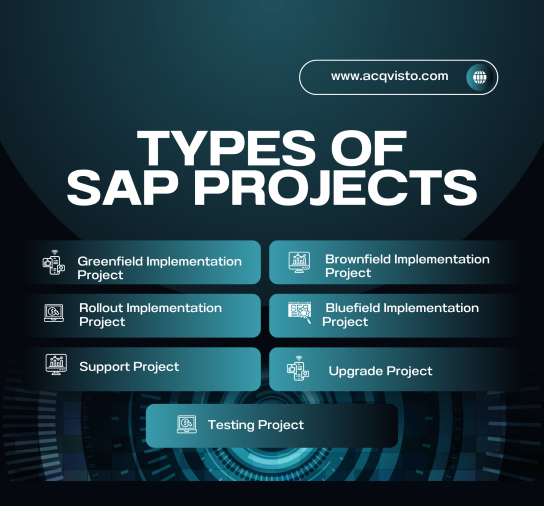SAP (Systems, Applications, and Products in Data Processing) is a powerful ERP (Enterprise
Resource Planning) platform used by organizations globally to streamline business
processes.Whether it’s finance, logistics, HR , SAP combines main functions into a central system.
Therefore,SAP projects can vary based on scope and need.There are different types of SAP Projects
based on Business goals and transformation needs.
We will explore the 7 major types of SAP projects commonly undertaken in the SAP ecosystem ,how
they differ, and what makes each unique.
1. Greenfield Implementation Project :
● A Greenfield implementation refers to building an entirely new SAP system from
scratch—without carrying over customizations or configurations from an existing ERP system
,which refers to a completely new deployment of SAP.
● This project approach is good for:
○ Companies moving from non-SAP systems
○ Organizations with outdated or heavily customized SAP system
○ Businesses seeking to standardize processes globally
● Benefits:
○ Opportunity to adopt SAP best practices
○ Removes technical debt
○ Streamlined architecture with Fiori
2. Brownfield Implementation Project:
● A Brownfield implementation refers to converting an existing SAP ERP system (like ECC)
into SAP S/4HANA without disrupting existing business processes.It retains historical data,
configurations, and processes.
● This approach is good for:
○ Companies with existing business processes but willing to modernize.
● Benefits:
○ Lower risk and cost than Greenfield
○ Shorter timeline
○ Continuity for end users
3. Rollout Implementation Project:
● As global organizations expand into new markets and business units, maintaining consistency,
compliance, and efficiency becomes difficult. One way to achieve this is through an SAP
Rollout Implementation—a project approach used to extend an existing SAP solution globally
to new geographies, business units, or subsidiaries adapting to local legal, tax and language
requirement.A global template is used and customized for local needs.
● This project is good for:
○ Global enterprises expanding operations or unifying regional business units under one
ERP landscape.
● Benefits:
○ Standardized processes across locations
○ Faster implementation using proven templates
○ Scalable for multi-country enterprises
4. Bluefield Implementation Project :
● Bluefield is a hybrid migration strategy that blends the best of Greenfield and Brownfield —
offering the flexibility to selectively migrate data, processes, and customizations from legacy
systems to S/4HANA. A bluefield implementation involves using existing SAP structures
while adding new functionalities, elements allowing for flexibility and innovation.
● This Project is good for:
○ Complex organizations that want to innovate but also retain some existing
configurations or history.
● Benefits:
○ Flexibility to innovate and retain valuable assets
○ Reduced risk and business downtime
○ Faster time-to-value with controlled transformation
5. Support Project :
● A Support project makes sure that the companies that already have SAP systems are running
smoothly by handling issues, enhancements, and queries. SAP consultants are needed to
check issues and prioritize solutions.These projects are extremely important for ensuring
business continuity, resolving issues, applying system improvements, and supporting end
users.
● Benefits Of Support Projects:
○ Minimizes system downtime
○ Improves user satisfaction
○ Provides continuous system improvement
● Types of Support:
○ L1 Support: Basic helpdesk, password resets, navigation help.
○ L2 Support: Configuration issues, troubleshooting functional errors.
○ L3 Support: Complex issues, debugging code, deep technical problems.
6. Upgrade Project:
● An Upgrade project involves upgrading existing SAP to a newer version of SAP, such as
moving from an older S4 HANA version to the latest one.It ensures that the organization stays
current with SAP innovations, security updates, and performance improvements.
● Benefits:
○ Improved system performance and security
○ Access to the latest SAP features
○ Compliance with SAP support policies
● Types of Upgrades:
○ Technical Upgrade: Upgrading the SAP system software and infrastructure.
○ Functional Upgrade: Leveraging new features and capabilities introduced in the latest
version.
○ Database Upgrade: For example, migrating from a traditional database to SAP
HANA.
7. Testing Project:
● A Testing project ensures that SAP functionalities are working correctly after a change,
upgrade, or implementation. It helps identify bugs, validate business processes, and prepare
the system for go-live These testing projects ensure the system functions correctly and meets
user requirements.
● Benefits:
○ Makes sure that process are accurate and complete
○ Boosts confidence among business users
● Types of SAP Testing:
○ Unit Testing: Testing individual components.
○ Integration Testing: To check that different modules works combinedly
○ User Acceptance Testing (UAT): Business users validate if the system meets
requirements.
○ Regression Testing: Ensuring existing functionality is not broken by new changes.
○ Performance Testing: Validating system response times and load capacity.




Add a Comment